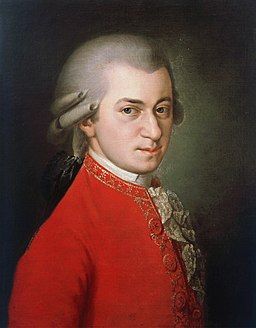 Wolfgang Amadeus Mozart (January 27, 1756 – December 5, 1791), born in Salzburg, Austria, was an important and respected composer. As an adult, he referred to himself as “Wolfgang Amadè Mozart,” but it is noted that his name had many variants. As a child, his baptismal record listed his name in Latin as Joannes Chrysostomus Wolfgangus Theophilus Mozart. Mozart was a prolific composer; over the span of his career composing hundreds of works including sonatas, symphonies, masses, chamber music, concertos, and operas.
Wolfgang Amadeus Mozart (January 27, 1756 – December 5, 1791), born in Salzburg, Austria, was an important and respected composer. As an adult, he referred to himself as “Wolfgang Amadè Mozart,” but it is noted that his name had many variants. As a child, his baptismal record listed his name in Latin as Joannes Chrysostomus Wolfgangus Theophilus Mozart. Mozart was a prolific composer; over the span of his career composing hundreds of works including sonatas, symphonies, masses, chamber music, concertos, and operas.
Wolfgang and his sister Nannerl were the only surviving children of Leopold and Anna Maria Mozart. Mozart’s mother came from a family of community leaders; and his father, Leopold, a successful violinist and composer, was a recognized musical talent in his own right and held the role of assistant concertmaster at the Salzburg court. Not only did Leopold teach young Wolfgang, but also his older sister, Maria Anna, who was nicknamed Nannerl. When Nannerl was playing keyboard at age 7, a 3-year-old Wolfgang began imitating his sister. His early and surprising grasp of concepts of musical theory soon had his father formally instructing him.
By the time Mozart was 5 years old, he had mastered the violin and keyboard. Leopold soon began a series of tours to courts to Bavaria, Paris, London, The Hague and Zurich with Wolfgang and Nannerl, where his prodigious children performed and were exposed to other musical talents.
In December 1769, Leopold and Wolfgang made a trip to Italy so that Leopold could display young Wolfgang’s talents to additional audiences. As Nannerl was now of an age that she could marry, she did not accompany them on the trip. It was the custom that women were not permitted to show artistical talent in public once they reached marriageable age.
Early years
Mozart’s mind was truly incredible. In Rome, after hearing Gregorio Allegri’s Miserere performed twice in the Sistine Chapel, he wrote the score out from memory. In doing so, Wolfgang Amadeus Mozart produced the first unauthorized copy of this closely guarded property of the Vatican. During this visit to Italy, the 14-year-old Wolfgang wrote Mitridate, re di Ponto (his fifth work for the stage!) for the court of Milan.
From the IPA Source database, Mitridate, re di Ponto (1770)
- Al destin, che la minaccia
- Già dagli occhi il velo è tolto
- Già di pietà mi spoglio
- In faccia all’oggetto
- L’odio nel cor frenate
- Lungi da te, mio bene
- Nel grave tormento
- Nel sen mi palpita
- Pallid’ombre, che scorgete
- Parto: nel gran cimento
- Quel ribelle, e quell’ingrato
- Se di lauri il crine adorno
- Se di regnar sei vago
- Se il rigor d’ingrata sorte
- So quanto a te dispiace
- Soffre il mio cor con pace
- Son reo, l’error confesso
- Tu sai per chi m’accese
- Tu, che fedel mi sei
- Va, l’error mio palesa
- Vado incontro al fato estremo
- Venga pur, minacci, e frema
Successive trips to Italy yielded two other commissioned operas, Ascanio in Alba (1771) and Lucio Silla (1772).
- Ah di sì nobil alma
- Al mio ben mi veggio avanti
- Dal tuo gentil sembiante
- Sì, ma d’un altro amore
- Torna mio bene, ascolta
In 1773, Wolfgang and Leopold returned from Italy. Archbishop von Schrattenbach, recently deceased, had been replaced by Hieronymus von Colloredo. Archbishop von Colloredo appointed Wolfgang as assistant concertmaster. During this time, Mozart composed symphonies, string quartets, sonatas, violin concertos, and operas. One of those operas was La finta giardiniera.
Here, from the IPA Source database, is La finta giardiniera (1774-1775).
- A forza di martelli
- Appena mi vedon
- Care pupille belle
- Che beltà, che leggiadria
- Chi vuol godere il mondo
- Con un vezzo all’Italiana
- Crudeli, oh dio! fermate
- Da scirocco a tramontana
- Dentro il mio petto io sento
- Dolce d’amor compagna
- Geme la tortorella
- Già divento freddo
- Mio padrone, io dir volevo
- Mirate che contrasto
- Nach der welschen Art und Weise
- Noi donne poverine
- Se l’augellin sen fugge
- Si promette facilmente
- Un marito, oh Dio – Nardo
- Un marito, oh Dio – Serpetta
- Una damina, una nipote
- Una voce sento al core
- Va pure ad altri in braccio
- Vorrei punirti indegno
Young Mozart soon grew frustrated in Salzburg and set out to seek more lucrative employment elsewhere. After resigning his post in August 1777, he set out for Mannheim, Paris, Munich, and Augsburg. As the Archbishop would not release Leopold, Mozart’s mother Anna Maria accompanied him. Although a few opportunities sounded promising, ultimately they either fell through or weren’t to his liking. Mozart fell into debt and started pawning his belongings. Mozart’s mother became ill and died in July 1778. It is said by some that Mozart’s financial situation probably delayed the call to a doctor until it was too late.
Meanwhile, Leopold was continuing to search for more gainful employment for his son Wolfgang back in Salzburg. Mozart returned and became the court organist in Salzburg.
Ready for more? Read part two of our blog on the life of Wolfgang Amadeus Mozart here.

One thought on “Featured composer: Wolfgang Amadeus Mozart (part 1 of 2)”
Comments are closed.